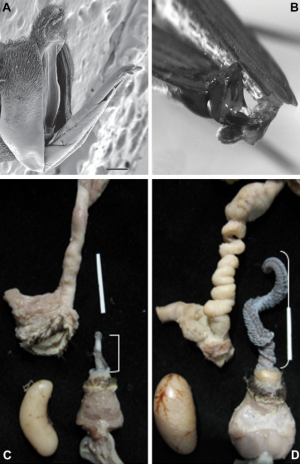Examples of studies investigating the evolution of both sexes’ genitalia. (A) The mobile female genitalia in the water strider Gerris gracilicornis with a genital shield that can block forced copulations, and the interlocking of female and male genitalia (B). Figure republished from Han and Jablonski (2009) under a CC-BY license. (C) and (D) show the covariation of female and male genitalia in different species of ducks in which the level of forced copulation covaries with length of the phallus and elaborateness of vaginas. (C) Harlequin duck (Histrionicus histrionicus) with short phallus, no forced copulations, and simple vaginas and (D) long-tailed duck (Clangula hyemalis) with high levels of forced copulation, long phallus, and elaborate vaginas (size bars = 2 cm).Credit: Brennan et al. (2007) with CC-BY license.
(Phys.org) —Animal genitalia are structurally diverse organs that can evolve rapidly under powerful selective forces exerted by the peculiarities of sexual reproduction. An overarching review of the existing evolutionary biology literature on animal genitalia, however, has shown that in recent decades the field has been increasingly and unjustifiably biased towards the study of male genitalia.
In a Perspective published May 6th in the open access journal PLOS Biology, researchers from Uppsala University in Sweden and Macquarie University in Australia conducted a literature survey of 364 scientific papers published between 1989 and 2013 that addressed the evolution of genitalia, analysing the amount of attention devoted to male genitalia, female genitalia, and those of both sexes. They also determined whether the gender focus depended on the specific research questions pursued or the animal groups studied.
Overall, they find that genital evolution research has focused much more heavily on male genitals. Surprisingly, this bias worsened over time, and during the last decade about 50% of studies were male-focussed, compared with 10% of studies on females, and 40% on both sexes.
"We found that the most plausible explanation for the bias is the enduring assumptions about the dominant role of males, and unimportance of variation in female genitalia," said Malin Ah-King, evolutionary biologist and gender researcher from Uppsala University.
The study revealed the pattern of bias to be strikingly different between different research questions investigated. Certain research questions seemed to direct researchers toward looking at both male and female genitalia (for example, studies of cryptic female choice, where females store sperm from different matings separately). Others, like those testing the lock-and-key hypothesis (in which male 'keys' fit species-specific female 'locks'), keep focusing primarily on males.
The authors then systematically asked whether several practical and biological issues might explain away this bias.
"Another contributory factor to the male bias could be the relative ease of studying protruding male genitals versus difficulties in studying female internal and often soft-tissue organs," said Malin Ah-King. "However, although the degree of bias differed across animal groups, it did not associate with the ease of study of male and female genital characteristics. Therefore the persisting male bias in this field cannot solely be explained by anatomical sex differences influencing accessibility."
Could the bias be due to comparatively limited variation among female genitals, perhaps justifying the focus on variation in male organs? Several detailed studies show large amounts of variation in genitalia between females in the same species, as well as between different species, suggesting that this is not a valid justification for bias.
The team also considered whether the gender of the investigators might explain the bias; however the pattern of bias did not differ between studies that have a male or a female senior author.
The authors conclude that the bias can't be justified on biological or practical grounds, and may therefore stem from historical intellectual misconceptions that may be hindering progress in the field by dissuading workers from studying important evolutionary properties of female genitalia.
"We think that this analysis can increase the awareness of gender bias and its impeding effects on research, and thereby enable a broadened understanding of genital evolution in the future."
More information: Ah-King M, Barron AB, Herberstein ME (2014) "Genital Evolution: Why Are Females Still Understudied?" PLoS Biol 12(5): e1001851. DOI: 10.1371/journal.pbio.1001851
Journal information: PLoS Biology
Provided by Macquarie University
























